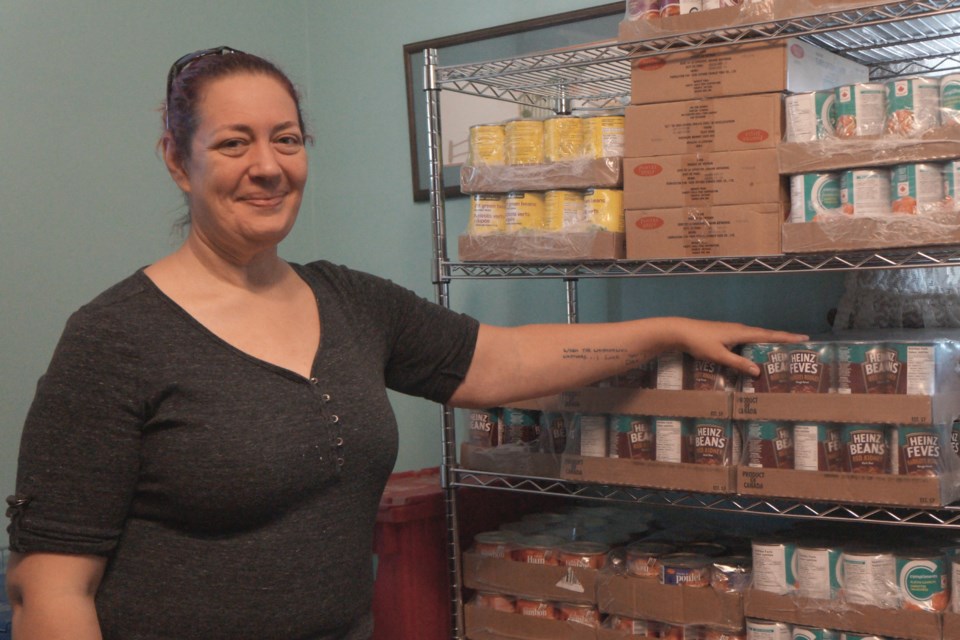An increasing number of families and households in Sudbury are turning to food banks in the wake of the pandemic, with a recent report from Food Banks Canada stating what Caroline “Ro” Mullen already knew: people are going hungry and supplies are short.
Mullen is the administrator for the Inner City Home of Sudbury, an emergency food bank service that also offers crisis support and life skills programs.
She said their food pantry has seen a 42 per cent increase in food bank usage. “And that's not since the beginning of COVID, that’s since 2021,” she said.
When Mullen began with the home in January, having previously spent a decade with the Salvation Army, she said she was prepared for a daily high of 35 households during the food banks limited and volunteer-run hours of 1 to 2:45 p.m. But the increases have come so quickly that the number was exceeded in her first week.
“I never saw anything less than 50,” Mullen said. “We've had as many as 69 households in one day” with limited hours.
She said that not only is the food pantry facing increased need, but their ability to fill the shelves is hampered by the rising cost of food, and the lack of it, especially staples like eggs. This spring found the Inner City Home forced to close their doors half an hour early due to lack of food, for the first time ever.
“People were expecting us to be open, coming in because they needed it, and then we had to turn them away. It was absolutely heart wrenching,” said Mullen. “And we couldn't get any more because the Sudbury Food Bank was low on donations, the grocery stores were low on food items, we just couldn't get it in. It's never happened before; it's unprecedented times for us.”
It’s unprecedented times across Canada. A report from Food Banks Canada shows that food bank visits in Canada have increased by over 20 per cent since 2019, with over 1.3 million visits to food banks in March 2021 alone; in Ontario, 419,532 visits. One third of those are children.
Food banks in larger population centres (100,000 people or more) are seeing a new wave of need with 28 per cent of food banks in these areas seeing visits more than double, compared to 2019. Clients in these areas were more likely to be racialized, to be two-parent households with children, and to need help because of job loss or reduced hours of work.
In Sudbury, Mullen said they are seeing increases from two groups: people who are homeless, and newcomers to Sudbury. “In August, we served 766 households; 64 of those were homeless. Most of them were families, or had at least two people in a household.”
Those who are newcomers often come for work, and most hold down multiple jobs, Mullen said. But still, they are unable to stretch their income. According to the Food bank Canada report, 9.6 per cent of the Ontarians who used food banks had a primary income from work.
That could be because the minimum wage is $15.50, and with a full time job, an income of approximately $620 per week could be seen as insufficient, especially for a family.
While 10 per cent of food bank users in Ontario are seniors, more than 50 per cent are reliant on social assistance, and 30 per cent of those are on disability support. The Ontario Disability Support Program payment was raised to $1,227.46 per month recently, but critics say it is insufficient pointing to rising costs, including housing and food.
According to Statistics Canada’s Consumer Price Index for May 2022, food prices rose 9.7 per cent compared to the previous year, the largest increase since September 1981. Just about everything is up, from meat to fruits and vegetables to pantry staples like flour and cooking oil — which rose 30 per cent. Pasta prices were up 20.7 per cent, bread 17.6 per cent, eggs 10.9 per cent and fresh fruit, 13.2 per cent.
Food Banks Canada's data shows that one-in-five (an estimated 7 million) Canadians now report going hungry — with 23 per cent reporting that they are eating less "than they think they should" because there isn't enough money for food.
“Years ago, statistics said most people are three paychecks away from being homeless,” said Mullen. “I think those numbers are drastically lower now; one paycheck, maybe not even. One or two missed days of work can make all the difference.”
Because of this, there is the need to fill the pantry at the Inner City Home of Sudbury, but also to support their programming, a series of classes seeking to end the cycle of poverty, including communication, stress management and anger management courses, offered onsite with volunteers.
Mullen said that food donations are always helpful, especially for children’s lunches (with consideration to allergies) but monetary donations will allow them to acquire the most food through buying agreements and buying in bulk.
The Inner City Home of Sudbury could also use volunteers. They rely on their dedicated 70 person volunteer rota, but there is much work to be done. Mullen said that a few hours here or there would help, and everything from helping with courses, administrative work to picking up supplies or even shoveling the porch at their 251 Elm Street West location. Even if you are not sure how to help, but have the desire, Mullen asks that you contact the Inner City Home of Sudbury. Their website is here.
